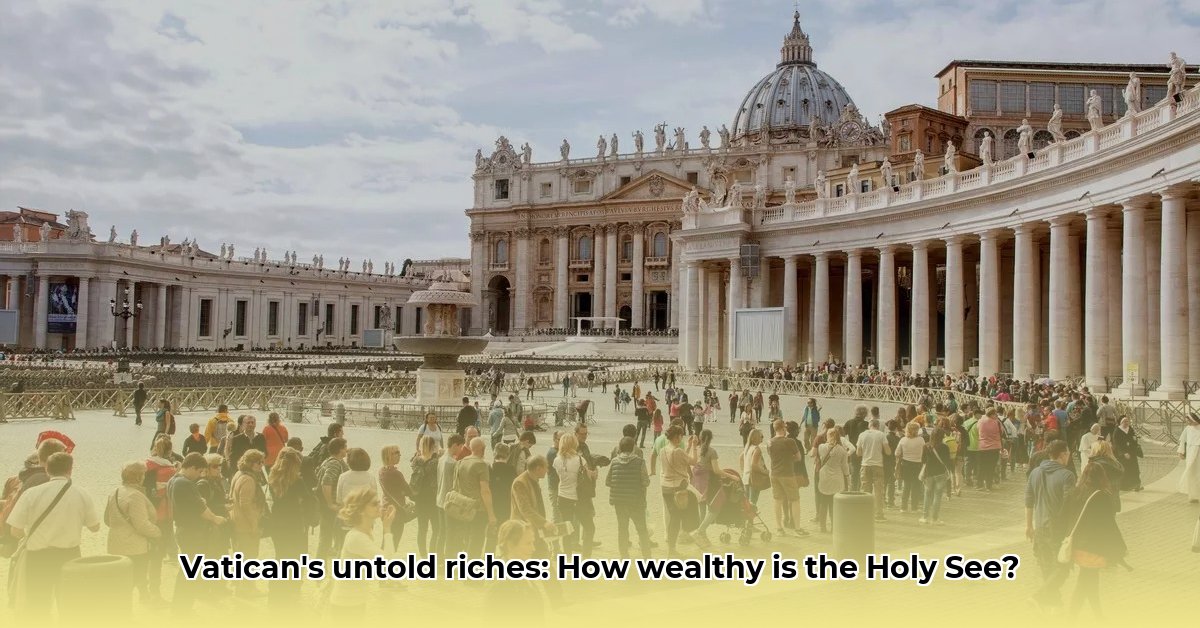Decoding the Vatican’s Financial Holdings
Determining the Vatican’s net worth is a complex endeavor, far more intricate than assessing a typical corporation. Its holdings blend the spiritual and temporal, encompassing the Holy See’s global religious influence and the Vatican City State’s sovereign territory within Rome. This unique structure, combined with limited financial transparency, makes precise valuation challenging. Instead of a simple balance sheet, we encounter a multifaceted portfolio of priceless art, extensive real estate, and investments shrouded in history.
What Contributes to the Vatican’s Wealth?
The Vatican’s assets fall into several key categories, each presenting unique valuation challenges:
Global Real Estate: The Vatican’s real estate portfolio extends far beyond Vatican City, encompassing properties worldwide. These range from historic churches and grand palaces to more mundane apartments and office buildings. Valuing these assets is difficult due to their unique historical and religious significance, along with the absence of comparable market transactions.
Art and Artifacts: The Vatican Museums house a collection of art and artifacts of immeasurable cultural and historical value. Masterpieces by Michelangelo, Raphael, and others reside within its walls. Assigning a monetary value to such irreplaceable items is inherently subjective and perhaps even inappropriate, given their significance beyond mere market price.
Investments: The Institute for the Works of Religion (IOR), often referred to as the Vatican Bank, manages a portfolio of stocks, bonds, and other investments. However, the precise composition and value of these holdings remain largely undisclosed, further complicating net worth estimations.
Gold Reserves: Speculation surrounds the extent of the Vatican’s gold reserves, as the exact amount remains undisclosed. This lack of transparency further obscures a comprehensive financial assessment.
The Challenge of Transparency
The Vatican’s historical opacity regarding its finances poses a significant obstacle to accurate valuation. While recent reforms under Pope Francis have promoted greater transparency, including the establishment of the Secretariat for the Economy, the Vatican is not subject to the same reporting requirements as publicly traded companies. This makes obtaining a comprehensive overview of its financial holdings challenging.
Differentiating the Holy See and Vatican City State
Adding to the complexity is the distinction between the Holy See, the central governing body of the Catholic Church, and the Vatican City State, the independent nation. These entities have separate budgets and financial structures. The Holy See receives income primarily through donations, including “Peter’s Pence,” and investment returns. Vatican City State generates revenue from tourism, including museum entrance fees and souvenir sales, as well as postal services and other activities.
Estimating the Vatican’s Net Worth: An Exercise in Approximation
Given the aforementioned challenges, estimating the Vatican’s net worth involves considerable conjecture. Published estimates range from $10 billion to upwards of $200 billion, reflecting the difficulty in valuing its unique assets and the lack of comprehensive financial disclosure. Some analysts focus on more readily quantifiable assets, like real estate holdings in major cities, while others attempt to incorporate the immeasurable value of artistic masterpieces and historical artifacts. It is important to treat any such estimates with caution, recognizing the inherent uncertainties involved.
| Asset Category | Valuation Challenge |
|---|---|
| Real Estate | Historical significance, lack of market comparables |
| Art & Artifacts | Immeasurable cultural and historical value |
| Investments | Limited disclosure, private holdings |
| Gold Reserves | Undisclosed quantity |
The Vatican’s Revenue Streams: A Diverse Portfolio
The Vatican’s income derives from a variety of sources:
Donations: Peter’s Pence, a global collection from Catholics, represents a significant source of income for the Holy See. These donations support the Pope’s charitable works and the Church’s global mission.
Investments: The IOR manages investments, primarily in European markets, generating returns that contribute to the Vatican’s financial resources. The exact nature and extent of these investments remain largely undisclosed.
Real Estate: Revenue generated from the Vatican’s extensive real estate holdings, including rent and property sales, though the scale of these revenues is difficult to quantify.
Tourism: Vatican City, a major tourist destination, generates substantial income from museum entrance fees, souvenir sales, and other tourism-related activities. This revenue stream contributes significantly to the Vatican City State’s budget.
Other Activities: Smaller revenue streams include the sale of stamps, coins, and official publications.
Ethical Considerations and Ongoing Debate
The Vatican’s significant wealth inevitably raises ethical questions regarding its role in addressing global poverty and inequality. The juxtaposition of vast financial resources and a commitment to humility and charity prompts ongoing debate about resource allocation and transparency. This tension underscores the importance of continued scrutiny and discussion regarding the Vatican’s financial practices.
Conclusion: A Financial Enigma
The Vatican’s net worth remains an enigma, shrouded in both historical secrecy and the unique nature of its holdings. While recent efforts toward greater transparency are commendable, a definitive valuation remains elusive. The Vatican’s financial structure, a blend of ancient tradition and modern finance, interwoven with its spiritual mission, continues to fascinate and fuel speculation. It is likely that ongoing research and increased transparency will provide further insights into this complex financial landscape in the future, but for now, the true extent of the Vatican’s wealth remains a subject of ongoing discussion and debate.










